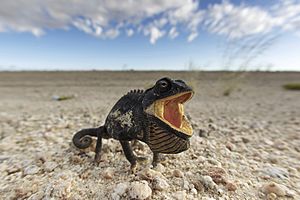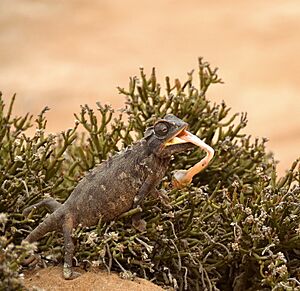Namaqua chameleon facts for kids
Quick facts for kids Namaqua chameleon |
|
|---|---|
 |
|
| Conservation status | |
| Scientific classification | |
| Genus: |
Chamaeleo
|
| Species: |
namaquensis
|
 |
|
The Namaqua chameleon (Chamaeleo namaquensis) is a special kind of lizard that lives on the ground. You can find them in the dry, sandy areas of western Namibia, South Africa, and southern Angola.
Contents
About the Namaqua Chameleon

The Namaqua chameleon is one of the biggest chameleons in southern Africa. It can grow up to 25 centimeters (about 10 inches) long! Female chameleons are usually larger than males. However, males have bigger heads and a bump under their tail.
Unlike chameleons that live in trees, the Namaqua chameleon has a much shorter tail. This helps it move around easily on the ground. It also has big spines on its back and a pointy part on the back of its head. Like many chameleons, it has special glands in its nose that help it get rid of extra salt.
This chameleon also has amazing skin that can soak up moisture, just like a sponge! It can drink water that touches its scales, using tiny channels to move the water across its body.
How They Control Their Body Temperature
Namaqua chameleons can change their color, which helps them stay comfortable. They are usually grey or brown with lighter patches. In the cool mornings, they turn black to soak up the sun's heat. When it gets hot during the day, they turn a lighter grey to reflect the sunlight and stay cool. Sometimes, they can even be black on one side and light grey on the other!
These chameleons are built for hot desert temperatures, but they can also handle cooler times. In their natural home, the air near the coast is about 19.3 °C (66.7 °F), and the ground is warmer, around 26.6-31.8 °C (79.9-89.2 °F). Further inland, it's even hotter.
Where They Live
You can find Namaqua chameleons all over the dry western parts of southern Africa. They are very common in the Namib Desert. They live as far south as Sutherland in South Africa and as far north as southern Angola.
They like dry and semi-dry places, like sandy deserts, rocky plains, and even areas near the ocean where the tide goes in and out. They mostly walk on the ground, but young chameleons are often seen climbing.
Their Behavior
What They Eat

Namaqua chameleons hunt in a special way. They slowly sneak up on their prey and then catch it with their long, sticky tongue. But sometimes, if their prey tries to run away, they will actually chase it down and grab it with their jaws!
They mostly eat insects, especially darkling beetles and grasshoppers. Sometimes, they also eat lizards (even young chameleons of their own kind!), snakes, and other small creatures. There was even a time when a chameleon was seen catching and killing a snake that was twice its size!
Some Namaqua chameleons that live near the coast also look for food in the areas where the ocean meets the land. This makes them the only chameleon species known to hunt for sea creatures!
When they catch dangerous prey, they quickly learn to disable its weapons first. For example, they might bite the head of a snake or the stinger of a scorpion before eating it.
These chameleons also eat plants in the wild. Plants can make up a good part of their diet, especially for those living near the coast. This suggests that Namaqua chameleons might be omnivores, meaning they eat both plants and animals.
They also swallow small stones, gravel, and sand. Scientists think this might help them digest their food or get rid of parasites. Chameleons that eat more plants also tend to eat more of these tiny stones.
Namaqua chameleons have a fast metabolism and eat a lot. They often eat until their stomachs are full, and then start eating again as soon as food moves into their intestines. In the wild, they might have about 12 meals a day, each with many large beetles! This is because there's a lot of food available in the Namib Desert.
How They Get Water
Water is super important for Namaqua chameleons. They drink dew and fog that collects on plants, rocks, and sand. Heavy fog often rolls in from the ocean in their habitat, especially in the mornings and afternoons. They also get moisture from their food, like beetles and plants.
Remember how their skin can soak up water? If water is placed on their side, it can travel across their body to their head and tail, where the chameleon can then drink it!
Unlike many desert reptiles, they have a very small bladder, so they can't store much water. But they get enough water from the regular fogs, their food, and by reabsorbing moisture from their urine.
What Hunts Them
Namaqua chameleons can be hunted by jackals, hawks, and eagles. Near towns, they can also be prey for pets like cats and dogs, and even foxes.
But these chameleons are fast for their kind! They will run to escape danger. If they feel threatened, they will quickly turn black, puff up their body, hiss, and open their bright yellow mouth to scare off the attacker. If they get cornered, they will charge and try to bite with their strong jaws, holding on tight and tearing at the attacker.
Social Life
When Namaqua chameleons grow up, they become very territorial. This means they claim a large area as their own and defend it. Fights often happen when their territories overlap, especially between chameleons of the same sex.
Female chameleons are bigger and more aggressive than males. So, fights between females are quite common. However, females have smaller territories than males. A female's territory might be around 382 to 868 square meters, while a male's can be much larger, from 1,250 to 1,718 square meters. These fights can sometimes cause serious injuries. After mating, the chameleon that owns the territory will force the other one to leave.
Young chameleons are not seen as a threat by adults, so they are mostly ignored. Young chameleons don't have their own territories and will even sleep together if they can.
Reproduction and Life Cycle
Namaqua chameleons can breed at any time of the year. After mating, the eggs stay inside the mother for 35-45 days. Female chameleons usually lay 2-3 groups of eggs each year, sometimes up to 4. Each group has about 10-13 eggs, but can have as few as 6 or as many as 22.
The eggs are buried under loose gravel and in moist sand, because dry sand can make the eggs shrivel. Sometimes, the mother will dig an extension of her resting burrow to lay the eggs. This might mean she cares for her eggs by keeping them close. In the wild, they dig a burrow about 20-25 cm deep and lay the eggs about 15 cm deep to reach the damp sand. The eggs are laid in layers, with 6-8 eggs in each layer. Digging and laying eggs can take 8-10 hours.
Interestingly, in captivity, other chameleons (male or female) might even help cover the hole after the eggs are laid! After being laid, the eggs take about 100 days to hatch. Young chameleons are better at climbing than adults.
Laying eggs uses up a lot of energy and fat from the female chameleon. After laying, females will eat as much as they can to get their strength back.
Courtship
During courtship, adult chameleons change to a mottled and spotted color. Only females who are ready to mate will accept a male. If a female is not ready, she will attack any male trying to mate. Because females are often larger, these attacks can seriously injure or even kill the male.
Burrowing Habits
Unlike chameleons that live in trees, Namaqua chameleons often use burrows to hide and rest. They sometimes use burrows dug by rodents, but they can also dig their own!
Protecting Namaqua Chameleons
Namaqua chameleons are listed under CITES II, which means their trade is controlled to protect them. In 2012, when the movie Mad Max: Fury Road was filmed, it caused some damage to the Namaqua chameleon's home in Dorob National Park and Namib-Naukluft National Park.
See also
 In Spanish: Camaleón de Namaqua para niños
In Spanish: Camaleón de Namaqua para niños



